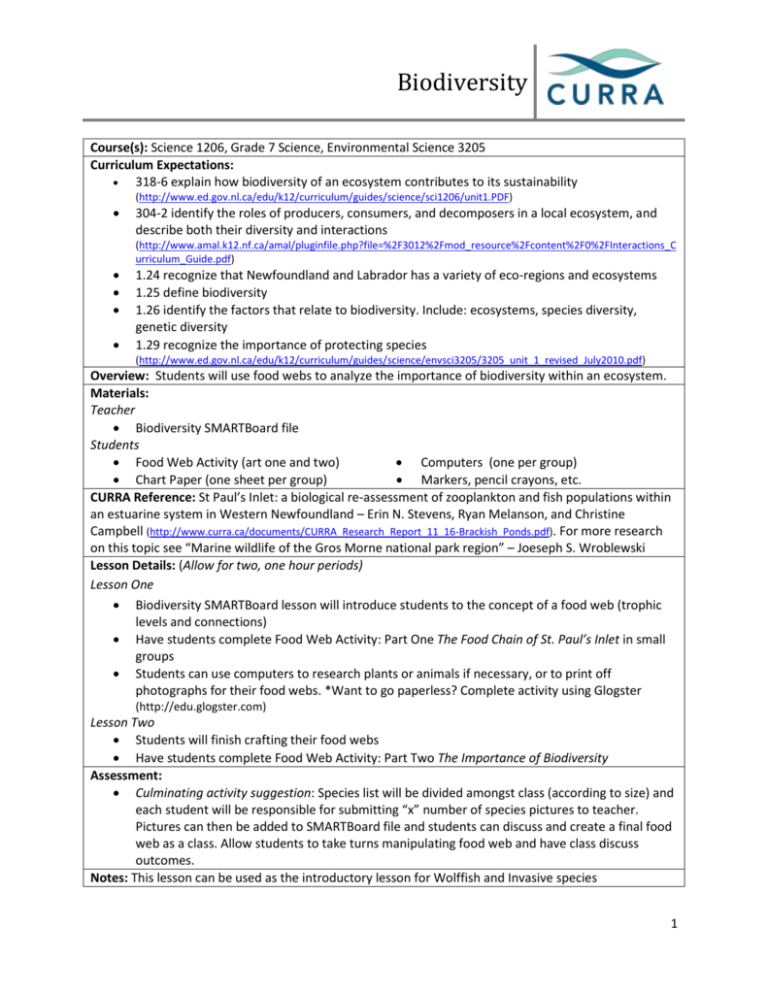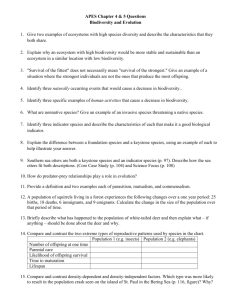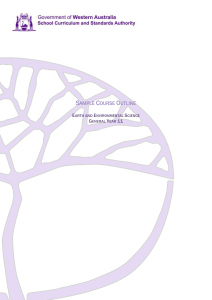Biodiversity LP
advertisement

Biodiversity Course(s): Science 1206, Grade 7 Science, Environmental Science 3205 Curriculum Expectations: 318-6 explain how biodiversity of an ecosystem contributes to its sustainability (http://www.ed.gov.nl.ca/edu/k12/curriculum/guides/science/sci1206/unit1.PDF) 304-2 identify the roles of producers, consumers, and decomposers in a local ecosystem, and describe both their diversity and interactions (http://www.amal.k12.nf.ca/amal/pluginfile.php?file=%2F3012%2Fmod_resource%2Fcontent%2F0%2FInteractions_C urriculum_Guide.pdf) 1.24 recognize that Newfoundland and Labrador has a variety of eco-regions and ecosystems 1.25 define biodiversity 1.26 identify the factors that relate to biodiversity. Include: ecosystems, species diversity, genetic diversity 1.29 recognize the importance of protecting species (http://www.ed.gov.nl.ca/edu/k12/curriculum/guides/science/envsci3205/3205_unit_1_revised_July2010.pdf) Overview: Students will use food webs to analyze the importance of biodiversity within an ecosystem. Materials: Teacher Biodiversity SMARTBoard file Students Food Web Activity (art one and two) Computers (one per group) Chart Paper (one sheet per group) Markers, pencil crayons, etc. CURRA Reference: St Paul’s Inlet: a biological re-assessment of zooplankton and fish populations within an estuarine system in Western Newfoundland – Erin N. Stevens, Ryan Melanson, and Christine Campbell (http://www.curra.ca/documents/CURRA_Research_Report_11_16-Brackish_Ponds.pdf). For more research on this topic see “Marine wildlife of the Gros Morne national park region” – Joeseph S. Wroblewski Lesson Details: (Allow for two, one hour periods) Lesson One Biodiversity SMARTBoard lesson will introduce students to the concept of a food web (trophic levels and connections) Have students complete Food Web Activity: Part One The Food Chain of St. Paul’s Inlet in small groups Students can use computers to research plants or animals if necessary, or to print off photographs for their food webs. *Want to go paperless? Complete activity using Glogster (http://edu.glogster.com) Lesson Two Students will finish crafting their food webs Have students complete Food Web Activity: Part Two The Importance of Biodiversity Assessment: Culminating activity suggestion: Species list will be divided amongst class (according to size) and each student will be responsible for submitting “x” number of species pictures to teacher. Pictures can then be added to SMARTBoard file and students can discuss and create a final food web as a class. Allow students to take turns manipulating food web and have class discuss outcomes. Notes: This lesson can be used as the introductory lesson for Wolffish and Invasive species 1 Biodiversity Food Web Activity Based on: St Paul’s Inlet: a biological re-assessment of zooplankton and fish populations within an estuarine system in Western Newfoundland – Erin N. Stevens, Ryan Melanson, and Christine Campbell (http://www.curra.ca/documents/CURRA_Research_Report_11_16-Brackish_Ponds.pdf) Part One: The Food Chain of St. Paul’s Inlet Listed below are some of the marine plants and animals found within St. Paul’s inlet, an estuary on the west coast of Newfoundland. Your task is to determine which trophic level each species belongs to and create a food web for the ecosystem. A blank trophic level pyramid has been provided below. Fish Species (remember to include both juvenile and adult fish in your food web!) Pungitius pungitius (Ninespine stickleback), Gasterosteus aculeatus (Threespine stickleback) Gasterosteus wheatlandi (Blackspotted stickleback) Apeltes quadracus (Fourspine stickleback) Tautogolabrus adspersus (Cunner) Myoxocephalus octodecemspinosus (Longhorn sculpin) Plant Species Zostera marina (Eel grass) Carex atratiformis (Scabrous black sedge/ Goose sedge) Ruppia maritime (Salt march grass) Zooplankton Species Acartia hudsonica Temora longicornis Evadne nordmanni Podon leuckarti Crustacean Species Homarus americanus (American lobster) Bird Species Sterna hirundo (Common tern) Sterna paradisaea (Arctic tern) Tringa semipalmata (Willet) Branta canadensis (Canada goose) 2 Biodiversity 3 Biodiversity Part Two: The Importance of Biodiversity Use your food web to answer the following questions on a separate sheet of paper. 1. Artic terns have been known to spend their summers in St. Paul’s inlet. This year, the population of summering terns has dropped drastically, only one quarter of the normal seasonal population have found their way to the inlet. Although scientists are unsure as to why this may have happened, can you predict how the decreasing tern population will affect the inlet ecosystem? 2. Remove three primary consumers from your food web. Explain how this will affect the inlet ecosystem. 3. Remove all of the secondary consumers from your food web. Explain how this will affect the inlet ecosystem. 4. Eel grass has a local nickname, “goose grass”, and this year there are many MANY geese residing in the inlet! Eel grass has become very sparse in the inlet. How does this affect the food web (hint: some species rely on eel grass for other needs than food!). 5. Why is it important to protect species? 6. Explain why biodiversity within an ecosystem is important. 7. Explain why biodiversity throughout the world is important. 4







